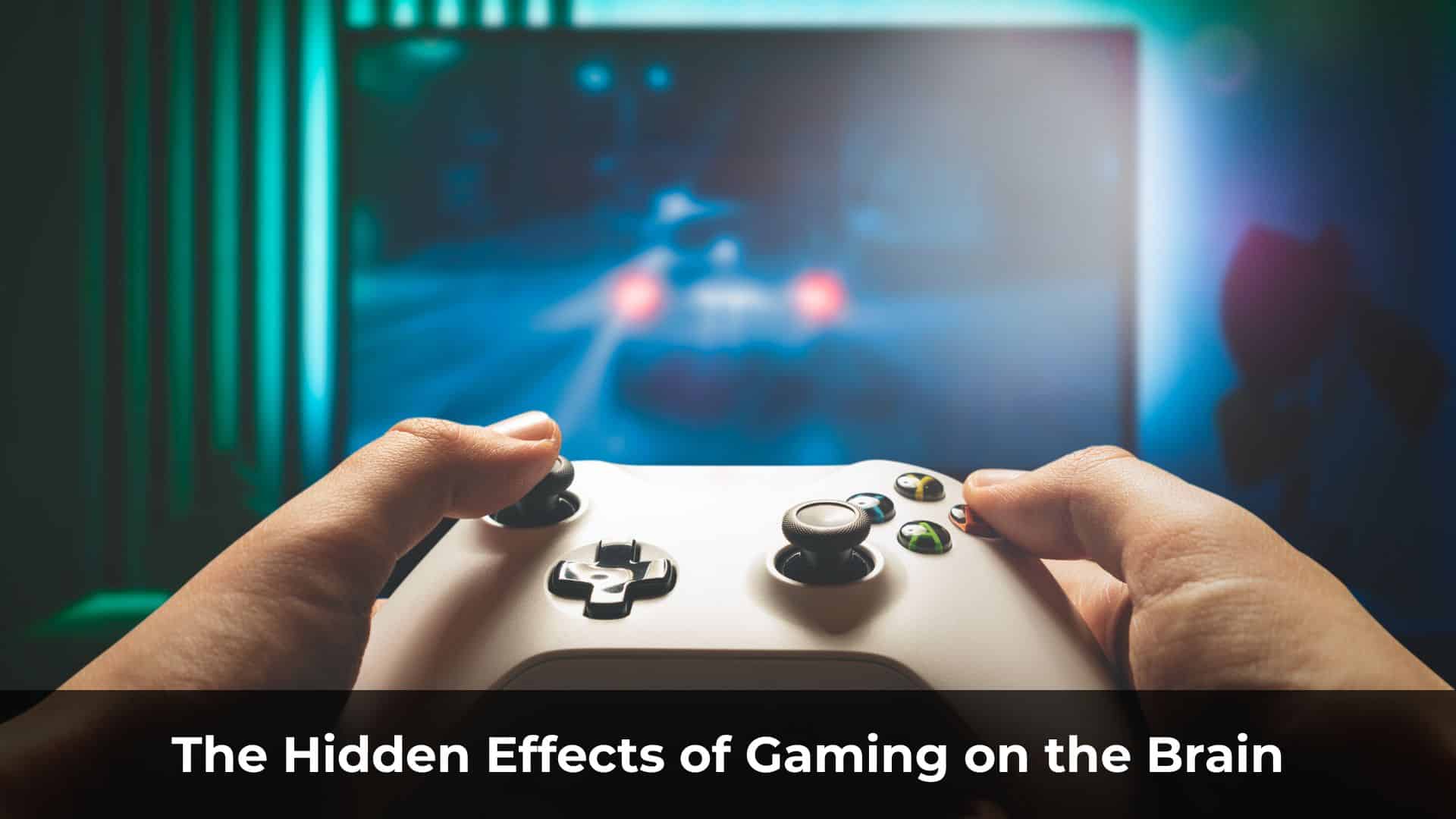If you’ve ever read articles online about video games, chances are you’ve come across glowing headlines praising their “benefits”—improved reflexes, sharper thinking, better problem-solving skills, and even social connection. But is that the whole story?
What many people don’t realize is that the gaming industry is one of the most powerful and profitable in the world today. Behind those flattering articles are often marketing campaigns disguised as journalism. Game companies hire content writers and influencers to promote the upsides of gaming while conveniently ignoring—or deliberately hiding—the darker side of it.
The truth is, for every “positive” benefit the media highlights, there are significant, long-term consequences that go unmentioned. From cognitive overload to emotional desensitization, the negative effects of gaming—especially when consumed excessively—can quietly erode mental health and brain function. And yet, because those stories don’t drive profits, they rarely make the headlines.
Table of Contents
ToggleThe Explosive Growth of the Gaming World
Just 15 to 20 years ago, my generation played on old-school gaming consoles—simple devices with only a few buttons and basic puzzle games. Back then, games were just a harmless way to kill time. They served as light entertainment when there were no better recreational options. We played to pass boredom—not to replace real-world experiences or physical activities.
But what we didn’t realize was how rapidly the gaming world would evolve. In less than two decades, gaming has exploded into a global industry now worth over $200 billion.
Today, the gaming industry generates more revenue than both the film and music industries combined. It’s no longer just a hobby—it’s a powerful economic and cultural force shaping how billions of people spend their time and attention.
This article isn’t about whether gaming is just for fun or whether it can become an addiction. Instead, we’re diving deeper—into how modern games are affecting a specific region of the brain responsible for focus and attention. And how, slowly but surely, that part of the brain is being rewired—or even damaged—by the very mechanics that make games so addictive.
The Boom of the Gaming Industry
Game companies are in constant competition, each trying to create the most engaging, addictive experiences to capture players’ attention—and ultimately, to maximize profits. It’s not just about fun anymore; it’s about who can dominate your time, your focus, and your wallet.
The world has changed. Conversations about cultural values or ethics have taken a back seat. In today’s economy, the driving question is simple: How do we make more money? That’s the primary mindset in business.
And if you were the owner of a gaming company, chances are you’d feel the same pressure. When faced with the lure of profits, it becomes increasingly difficult to stay grounded in moral responsibility. After all, what’s easier to care about: the mental well-being of players, or the luxury car parked in your driveway?
That’s why many companies design games to be as addictive as possible. The goal isn’t just entertainment—it’s retention and revenue. And behind every hit game is a massive team to support: developers, marketers, designers, customer support, office leases—the financial engine must keep running, no matter the human cost.
Game Developers Are Engineering Addiction—for Profit
Game development teams today are handsomely paid and backed by deep resources. They don’t just build games—they study psychology, run tests, and fine-tune every feature to make the product as engaging—and addictive—as possible.
Many people say, “I just play for fun.” But that’s exactly what the game makers want you to believe. They lure you in with lighthearted entertainment, then slowly trap your attention. When there’s an entire team dedicated to maximizing addictiveness, very few players stand a real chance of resisting.
Think of it this way: Cigarette packs come with a warning—“Smoking is hazardous to your health.” Likewise, in many countries, games carry a label: “Playing more than 180 minutes per day can negatively affect your health.” But let’s be honest—how many people actually take that warning seriously?
Nicotine is the addictive chemical in cigarettes. In games, it’s dopamine—the brain’s reward chemical. Every level, achievement, or flashy animation is engineered to trigger a dopamine hit, keeping you coming back for more. And just like nicotine, that reward loop can quietly lead to dependence.
The Hidden Damage: How Gaming Hijacks Dopamine and Rewires Your Life
Dopamine is a neurotransmitter in the brain responsible for motivation, pleasure, and the feeling of reward. It plays a key role in helping us pursue goals, stay focused, and feel fulfilled when we achieve something meaningful.
Normally, dopamine is released after sustained effort—finishing a tough project, launching a business, or accomplishing a personal milestone. That rush of dopamine reinforces the value of hard work and progress, making us feel genuinely satisfied and motivated to keep growing.
But gaming shortcuts that process.
In video games, every time you level up, unlock an achievement, or complete a mission, your brain releases a burst of dopamine—instantly. This artificially induced “high” feels good, and your brain starts craving it again and again. The more you play, the more those dopamine spikes are reinforced, conditioning your brain to associate gaming with reward and pleasure.
What starts as innocent curiosity quickly turns into dependency. You don’t even realize it, but your brain begins to prefer gaming over everything else—because nothing else gives that same immediate hit of excitement.
Studying? Too boring. Working? Too slow. Cleaning the house? Why bother?
Real-world efforts take time. Whether it’s building a career, running a business, or mastering a skill, meaningful progress requires patience and consistency. But games are engineered to skip the hard part and deliver dopamine on demand.
And unlike real-world challenges, games are always there—just a tap away on your phone or computer, waiting to reward you instantly.
Over time, your brain adapts to this constant flow of dopamine. It builds a tolerance. You stop feeling joy from everyday activities, and only find excitement in games. Motivation for anything else slowly fades. You’re no longer chasing goals—you’re chasing dopamine.
Gaming Is Too Easy, Too Comfortable—And That’s the Problem
Our brains are wired to avoid pain and seek pleasure. It’s a survival mechanism. And video games offer a perfect shortcut to both—instant comfort, instant gratification.
You sink into a couch, open a game, and within seconds, you’re relaxed, distracted, and completely disconnected from the stresses of real life. No pressure. No risk. Just dopamine on demand.
Your brain quickly learns: Gaming feels good. Real life feels hard. And with enough repetition, that belief becomes internalized. Life becomes something to escape from, and gaming becomes the escape.
But here’s the catch: that pleasure is artificial.
After hours of nonstop gaming, you’re left drained, not fulfilled. What once felt exciting turns into numbness. Real life starts to feel dull, meaningless—even pointless. This is the paradox of overstimulation: the more you chase quick dopamine, the harder it becomes to enjoy real things.
And then comes the money trap.
In online games, players are encouraged—or pressured—to spend real money to gain an edge. Buy new gear. Beat your enemies. Show off your status. This “pay-to-win” model fuels a psychological loop of reward and superiority, often leading players to spend far beyond their means.
Some gamers have burned through thousands—even millions—in pursuit of digital power and prestige. It’s why many call these games “bloodsuckers”. Because they don’t just drain your time and energy—they drain your wallet too.
In the end, gaming doesn’t just hijack your brain. It can slowly strip away your health, your focus, your finances—and even your sense of purpose.
How Can You Reset Your Brain Back to Normal?
You probably don’t want to end up like the “Otaku” stereotype in Japan—spending entire days locked indoors, glued to a screen, completely detached from the outside world.
But once you’ve fallen into gaming addiction, how do you bring your brain back to its natural, balanced state?
The answer is simple, but not easy: stop playing—and wait.
Take a break. Let your brain detox. Give your dopamine levels time to recalibrate. When that happens, you’ll slowly start to rediscover joy in other parts of life—real joy, not just digital highs.
How long does it take? That depends. Every brain is different. Some people might need just a few days, others several weeks. The more sensitive your brain is to stimulation, the longer it may take to fully reset.
But here’s the catch: it’s not just gaming that disrupts your brain’s balance.
Social media, porn, endless TikTok scrolling, the compulsive habit of checking your phone every five minutes—all of these create the same effect: constant dopamine spikes, followed by a loss of motivation and focus.
So even if you quit gaming, but continue feeding your brain with digital “junk food,” your motivation won’t come back. You won’t feel like studying. You won’t feel like working. You’ll just feel… stuck.
To truly regain your drive, your focus, and your sense of meaning—you need to give your brain space to breathe. Silence the noise. Embrace boredom. And let real life start to feel rewarding again.
A Step-by-Step Guide to Dopamine Detox (Breaking Free from Gaming)
Many people want to quit gaming—but just can’t. They want to socialize, be more productive, or start new habits—but feel stuck, unmotivated, and drained. If that sounds like you, it may be time for a dopamine detox.
And no, it’s not just about quitting video games. To truly reset your brain, you need to reduce all high-dopamine activities that keep it overstimulated—social media, adult content, endless scrolling, and compulsive phone use. Your brain needs space to rest, to heal, and to come back into balance.
From experience, taking a break from gaming for 30 to 90 days can make a huge difference. That doesn’t mean you have to quit gaming forever—unless you want to—but your brain needs time away to recover and return to a healthy baseline.
If you’re able to quit completely and focus on building a meaningful career or life path, even better. But that’s a big leap—and not everyone can or needs to do that.
What matters is this:
If you can stay off games for even just 30 days, you’ll likely experience a powerful mental shift. Your perspective on life will change. You’ll start to see things differently—clearer—compared to when you were trapped in the loop of constant stimulation.
And remember: detoxing from dopamine doesn’t stop at games. You must also step back from social media, porn, and other addictive content. Otherwise, your brain never gets a real break.
The goal isn’t to eliminate dopamine entirely—that’s impossible and unnecessary. The goal is to restore your brain to its natural rhythm, so that it can start enjoying everyday life again.
Over time, you’ll begin to feel joy in simple things: studying, working, exercising, spending time with friends, reading books, playing with pets.
You’ll stop feeling like your brain is broken or hijacked by games and algorithms.
You’ll feel free again.
Take the 30-Day Quit Gaming Challenge
If you’re serious about quitting games, start by building a clear plan. This isn’t just about willpower—it’s about strategy.
Begin by installing apps that block games completely. Remove every game from your computer. Block websites where you can download or play games. Create friction. Make it hard to relapse.
On your phone, delete all games. Then install screen-limiting apps that lock down social media and limit your screen time. Social media can be just as addictive as games, and both flood your brain with dopamine.
If you struggle with adult content, consider going one step further: disable Incognito Mode in your browser. You don’t need to delete Chrome entirely—just block private browsing to remove the temptation. You can also limit new app installations and set up basic filters to keep your digital environment clean and focused.
Need to search for information? Use a proper workstation—a laptop or desktop with a large screen. It’s more productive, and less tempting than a tiny phone full of distractions.
Be prepared: the first few days will feel boring, maybe even painful. Your brain is starving for stimulation. That’s normal.
Replace gaming with something better. Find a new hobby. Learn a real-world skill. I recommend looking into online business. There are low-cost ways to start side hustles or small businesses that can eventually generate income.
Soon, you’ll realize how easy it was to spend money in games—and how hard it is to earn real money in life. But that’s the point. That challenge is what makes life rewarding.
This 30-day challenge won’t be easy. But it’s not impossible either.
I wish you strength, discipline, and success. You’ve got this.













